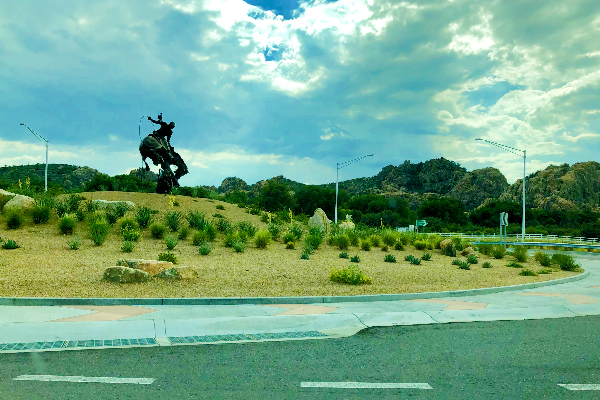Roundabouts are becoming increasingly used instead of intersections in Arizona. Locally, there is a project finishing up in Prescott that has added roundabouts to 89 highway along the stretch that connects Prescott to Chino Valley.

Research has shown that they improve traffic and reduce accidents greatly. They are also fun to drive if you understand how they work!
How to Drive Around Roundabouts
As you enter a roundabout, remember two key points:
- Never merge. The right of way is observed at the yield sign. Motorists already in the roundabout have the right of way. You must slow down or stop to yield to traffic approaching from the left. Wait for a gap in traffic, then carefully proceed into the roundabout.
- Go SLOW:
- Slow down to 15-25 mph when entering.
- Let vehicles already circulating go ahead.
- Obey all one-way signs.
- Watch for pedestrians, bicyclists, emergency vehicles and large vehicles.
For multiple-lane usage, follow these guidelines depending on traffic patterns:
- For right-hand turns, travel in the right-hand lane and use your turn signal.
- For left-hand turns, travel in the left-hand lane and use your turn signal.
- For continuing forward, remain in the same lane you entered.
- For missed exits, circle around the roundabout again.
Benefits of Roundabouts
According to the Insurance Institute of Highway Safety (IIHS), there are many safety benefits associated with the modern roundabout:
- 90 percent reduction in fatal crashes
- 75 percent reduction in injury crashes
- 30-40 percent reduction in pedestrian crashes
- 10 percent reduction in bicycle crashes
- 30-50 percent increase in traffic capacity
There other benefits to roundabouts, including
- reduction in fuel use and pollution
- no signal equipment to install and repair
- quieter neighborhoods
Cost of Roundabouts Vs. Signals
The price tag of modern roundabouts versus traditional traffic-control methods can vary. Demographics, geography and environmental elements all make a difference when engineers, communities, and city and state planners begin to consider how to move traffic from one street to another.
Sometimes the financial cost of right-of-way acquisition is higher than the cost of traffic signal construction, and sometimes it is not a factor. For example, though modern roundabouts do not require traffic-light electricity, the maintenance of landscaping or public art can be a cost. However, the reduction in fatal, injury and pedestrian crashes can reduce other costs, including car insurance premiums, health insurance premiums, and physical and emotional trauma. When safety factors go up, the cost to society goes down.
History Of Roundabouts
Traffic circles have been part of the transportation system in the United States since 1905, when the Columbus Circle designed by William Phelps Eno opened in New York City. Subsequently, many large circles or rotaries were built in the United States. The prevailing designs enabled high-speed merging and weaving of vehicles. Priority was given to entering vehicles, facilitating high-speed entries. High crash experience and congestion in the circles led to rotaries falling out of favor in America after the mid-1950’s. Internationally, the experience with traffic circles was equally negative, with many countries experiencing circles that locked up as traffic volumes increased.
The modern roundabout was developed in the United Kingdom to rectify problems associated with these traffic circles. In 1966, the United Kingdom adopted a mandatory “give-way” rule at all circular intersections, which required entering traffic to give way, or yield, to circulating traffic. This rule prevented circular intersections from locking up, by not allowing vehicles to enter the intersection until there were sufficient gaps in circulating traffic. In addition, smaller circular intersections were proposed that required adequate horizontal curvature of vehicle paths to achieve slower entry and circulating speeds.
These changes improved the safety characteristics of the circular intersections by reducing the number and particularly the severity of collisions. Thus, the resultant modern roundabout is significantly different from the older style traffic circle both in how it operates and in how it is designed. The modern roundabout represents a substantial improvement, in terms of operations and safety, when compared with older rotaries and traffic circles


